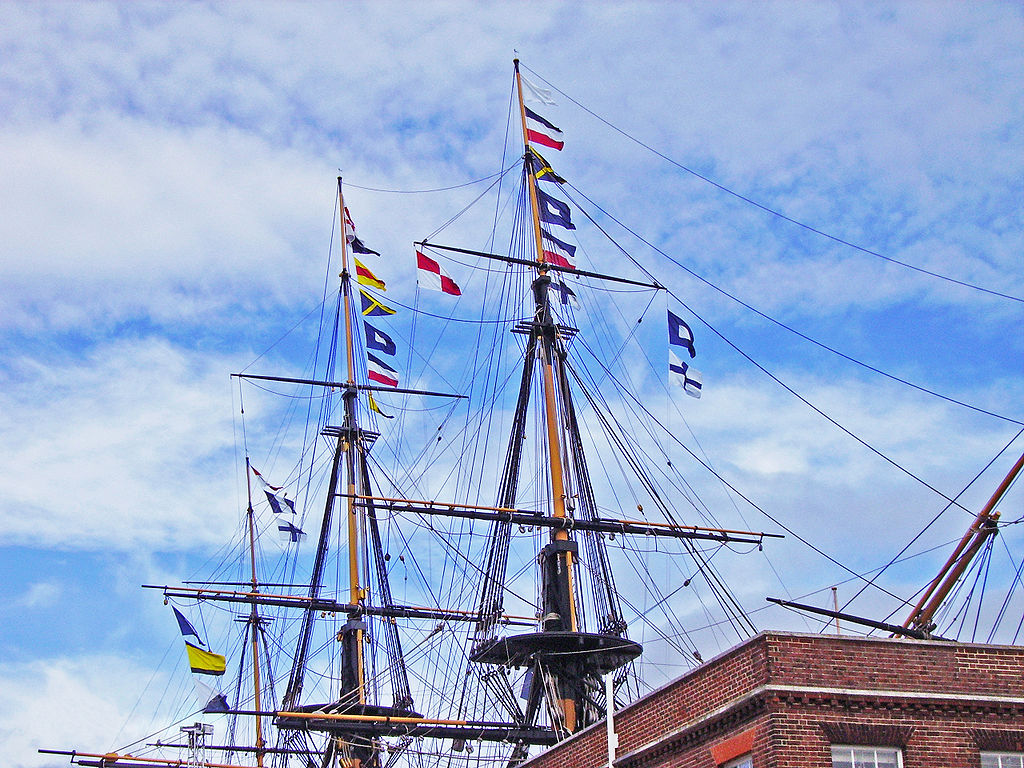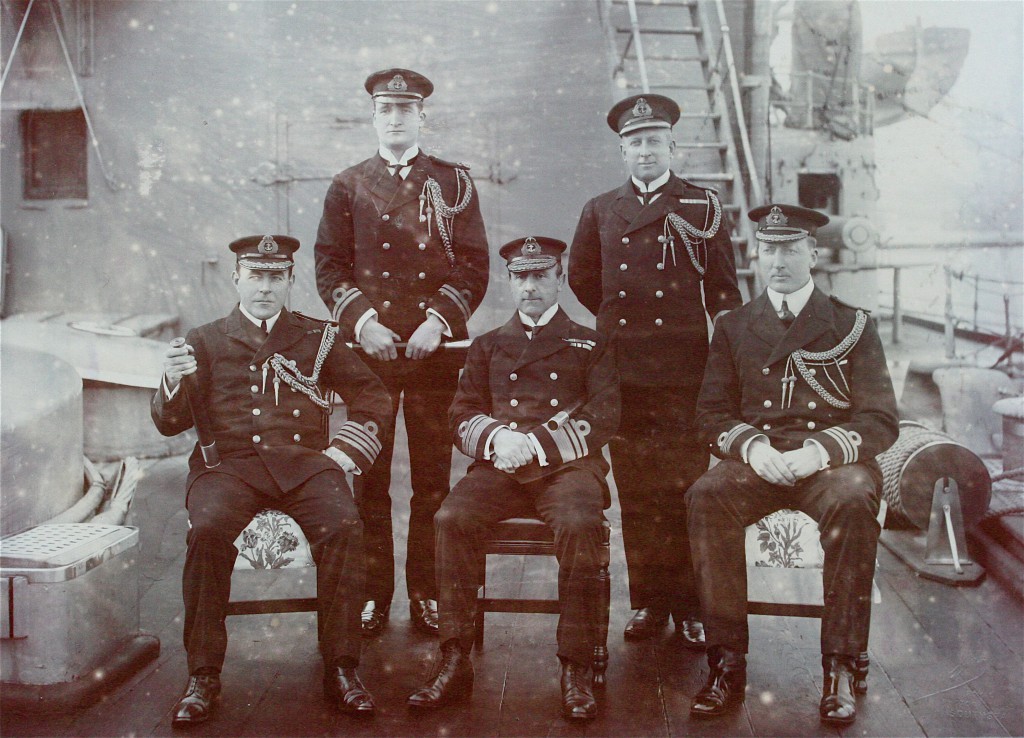The biggest challenge of war at sea has always been figuring out where the enemy is and controlling your forces against him. For centuries, options were very limited. Your sensor was a man at the top of the mast, maybe with a telescope, and your only option for communication over any distance was signal flags. The world ended at the horizon, or maybe a little further if someone else was signalling to you. Information traveled at the speed of ships, which meant that it was next to impossible to build up a useful picture of the movements and intentions of an enemy before it became obsolete.

A sailing ship signalling with flags1
This began to change when the telecommunications revolution kicked off. One notable example of the shift that resulted was a change in British press policy. During the Napoleonic Wars, it was common for troop movements to be publicly announced when they happened. This was still policy at the start of the Crimean War, but it was soon realized that the telegraph meant that the news of the troops departure reached the Russians long before the troops did, and the policy was changed.

Admiralty House, Malta, where Fisher set up the first plotting table
It took a bit longer for the telegraph to have an impact at sea, and early uses, most notably during the Spanish-American War, were rather slapdash. In fact, it wasn't until Jackie Fisher was in command of the Mediterranean Fleet that the first systematic use of information from sources outside the fleet was made. Fisher, responsible for protecting the vital route through the Med between Britain and India in 1899-1902, was faced with three separate enemy forces. He had the strength to defeat the French Mediterranean Fleet, the French Atlantic Fleet or the Russian Black Sea Fleet in isolation, but if all three combined, they would be able to crush him. Fisher realized that it was possible for him to predict the movements of these fleets, because to coordinate their actions, the Russians and French would need to pass messages through the British-controlled cable network. Malta, his headquarters, was an important node in this network, with cables tying together France, French North Africa, and Russia. Fisher persuaded the manager of the station to give him copies of any messages of interest, and set up a codebreaking cell to decrypt them. This would not only tell him where his enemies were, as the existing network of agents in various ports provided, but also where they were going to be. This information was fed to a group responsible for plotting it on a table kept in Fisher's headquarters, allowing him to take in the state of the Mediterranean at a glance.

HMS Inflexible, one of the early battlecruisers. Note the high masts, intended to improve radio performance
Shortly after Fisher left the Mediterranean, he was chosen to serve as First Sea Lord, in response to the fiscal crisis brought on by the Boer War. The British couldn't afford to build enough armored cruisers to counter the French and Russian commerce raiders in the traditional manner, but Fisher proposed to combine his system with fast turbine-powered hunters, cutting the bill for trade protection substantially. While the British could count on some information from codebreaking on the cable network, other sources of intelligence would be necessary. The main ones were the network of agents the British had in ports worldwide, and the incomparable information on commercial shipping provided by access to Lloyd's of London, which insured virtually all of the world's maritime trade.

The Royal Exchange, home of Lloyd's of London
However, the biggest factor in allowing the system to work was the development of radio, which not only allowed forces at sea to be directed with the knowledge available on land, but also provided new ways to gain information on enemy forces. Most obviously, radio messages could be decoded without needing control of a cable station. Even when that wasn't possible, direction-finding would provide bearings, which could be plotted if multiple stations picked up the signal.2 All of this information was fed into a plot at the Admiralty, which proved able to locate ships with exceptional accuracy. This was tested first during the Russo-Japanese War, when the plot proved more accurate than the positions reported by more conventional intelligence. The British cable network, quickly supplemented with radio stations, allowed the Admiralty to pass all of this back to the fleet anywhere in the world, but this level of control was a major challenge to the traditional deference given to commanders at sea, and the change won Fisher many enemies.
The system was not entirely successful during exercises, nor during its first operational trial during the pursuit of the Goeben and Breslau. Poor coordination meant that Troubridge's sighting of the German ships was not acted upon in time to destroy them. However, the system worked somewhat better in the North Sea. The first test, in December 1914, failed because the British commander steered for the current position of the Germans, instead of the position for an intercept. This mistake was not repeated, and virtually all later German fleet sorties were detected and tracked, most prominently through the efforts of the cryptanalysis section at Room 40. This system was responsible for the only clash between the two fleets, when they vectored Jellicoe to intercept the German fleet at Jutland. The Germans, unaware of the British tracking methodology, ascribed this to a freak encounter with a British force headed into the Baltic.

Jellicoe (center) and Dreyer (right)
Jutland also saw the first use of plotting on a tactical level. This was very similar to Fisher's strategic plot, but on a much smaller scale. It was the brainchild of Frederic Dreyer, Jellicoe's flag captain and the inventor of the standard British fire control system. This allowed Jellicoe much better situational awareness than Scheer could muster, allowing him to repeatedly cross the German T and dodge their torpedoes successfully. This performance was achieved despite the primitive state of plotting. Most ships reported their position in absolute coordinates. As it had been many hours since star sightings could be taken in the overcast North Sea, this resulted in differences of several miles. The problem was later solved by plotting on the flagship. Beatty did not keep a plot at all, rendering him ignorant of German movements in the runup to the deployment. There were also ships which did their dead-reckoning poorly. Jellicoe's plot showed a battlecruiser at 60 kts and a cruiser doing only 3. The situation was made worse by limited radio channels, which the Germans were also trying to use at the same time.

Iron Duke
While the methods developed by Fisher and Dreyer and used during the First World War were primitive, they laid the foundation for the great innovations made, both in the air and on the sea, during the second. A confluence of a few brilliant officers and the new technology of radio allowed navies to begin to evolve away from being dominated by sheer numbers to the use of information being the deciding factor that it is today. We'll look at the next stage of that evolution next time.
1 As you might expect, this is HMS Victory making (most of) the famous signal, England expects that every man will do his duty. ⇑
2 Ships could often be identified from interceptions without codebreaking. Until after WWII, radio messages were often sent by hand in Morse code, and the "fist" of a radio operator could be identified. The awareness of the capabilities of radio intelligence meant that the British were much more interested in radio silence than any other power. This has persisted to some extent to the present day. ⇑

Comments
It would have been theoretically possible to put together functional radios in 1800. If the French had done so, just what level of difference could that have made?
I don't know enough about what radio technology was possible at that time, or about the specific strategic circumstances to say for sure. But a couple of frigates scouting with radio would be a huge benefit to France, as they can figure out where the English fleet is from a long way away. It's not as useful as it would be a century later, as wind still controlled movement to a degree not seen under steam, but it should make it a lot easier to defeat the English in detail, snapping up individual ships and small units. That could, over time, shift the balance of power significantly.
One of the other things that had to be learned, though, was just when and how to disseminate information and when to order action; when to trust the man on the spot to make the right decision, and when to override him.
(WW I in general had a fair amount of over-stifling over-centralization, and WW II was a bit better at decentralization, but then it also had things like centralized convoy routing from the operational plotting room at the Admiralty... it would be very nice to see something on this.)
More on land than at sea. The tradition of seaborne autonomy was very strong, and radio just wasn’t very good yet.
On the convoy routing system specifically? That's not a bad idea. I may have to do something on that.
Doctorpat:
Another question is, how long would it have taken the British to make their own radios?
Surely they had spies in France and could at some point capture a set in battle (or have someone sneak aboard a radio fitted ship in port and steal it).
@anon
I think that depends on how advanced the French radios are?
The French and British had similar industrial bases, so that's probably not a huge issue in this case, but in general copying tech requires having the necessary industrial base, engineering, and so on. This is a key point in a lot of alt history, (AKs teleported to the Civil War type thing), but more prosaically in the various colonial wars capturing artillery didn't really help, because sustaining it beyond whatever was captured, much less copying it, requires foundries, precision machining, consistent shells, and so on. Similarly, capturing the plans and a few sets of telegraph equipment doesn't help without having access to sufficient supplies of wire and so on.
I was thinking in terms of a time traveller introducing the radio. The actual industrial base required was very little. You needed wire (in mass production for thousands of years, what do you think chain mail was made from?) gold or silver leaf capacitors (made as court playthings since the 1600s) and maybe some glass blowing tech. A few buckets of acid and some copper and zinc for the batteries and you'd be sending simple dots and dashes. The Romans could probably make one if they knew how. (It would be even more clumsy and I'm not sure they could manage any form of vacuum valve. They wouldn't have the glass blowing. I guess you could try pottery???) Both the scientific communities of France and England c.1800 could knock out a handful of radios per year without needing new capacity. Though France was probably behind having smashed up and executed a big chunk of the upper-class-idle-scientists during the revolution.
Ironically, the telegraph, which was actually made much earlier, required far more industrial capacity because you needed hundreds of km of insulated cable, not a few meters of the stuff that could be handmade by any competent silversmith.
@doctorpat
I think they could probably have made a spark gap transmitter with their existing technology, which gives them at least primitive radio. However, that's not very efficient in terms of bandwidth or power usage, so they would need either a very large battery bank or a dynamo of some sort to transmit while at sea.
Tube radios are more efficient on a number of axes, but I don't think that 18th or early 19th C tech would have been able to reproduce the electrical components with the necessary repeatability and precision to really take advantage of that, though I'm not an expert on it by any means.
bean wrote: "Most obviously, radio messages could be decoded without needing control of a cable station."
They could be intercepted. Decoding (or cryptanalysing) is a separate matter, regardless of how the message was acquired.